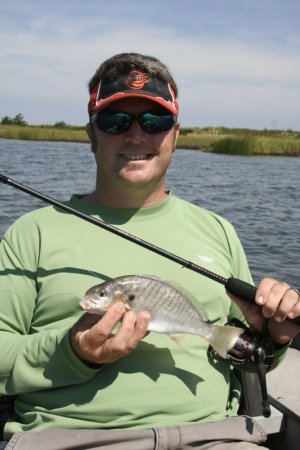When I was growing up back in the 1940s and ’50s, my grandfather only brought home first porgies and then croaker. By the time I was old enough to fish with him, croaker were the main target species. It didn’t matter if we were fishing out of Bivalve, Md., or Slaughter Beach, we were after croaker. I have no memory of catching a flounder until I returned from the Navy in 1965, and then we caught winter flounder on bloodworms hand over fist in the spring. I would say summer flounder didn’t enter the picture until sometime in the 1970s, and then only as a bycatch with trout.
When Pop brought a lard can full of croakers home (coolers didn’t exist back then), he would take them to the basement and clean them in our stationary tubs. I would stand on a box and watch as he removed the scales, the head, fins and guts, washing what was left before placing the body in a big bowl that I would take up to my grandmother in the kitchen. Mom-Mom would rewash the fish and go over each one, looking for even the teeniest bit of scale or offal that Pop might have missed.
After the fish passed her inspection, it was given a bath in well-beaten egg, dipped in flour and fried up in bacon grease. In my humble opinion, that made the skin of the fish the best-tasting part. You can imagine what it did for fried chicken. If I was really lucky, we would have lima beans and fresh corn cooked along with fatback. Come to think about it, almost everything I ate growing up with my grandparents, who happened to be from Sussex County, was cooked in some sort of pig fat. And it was delicious!
Today, spot, croaker and kings make up a good trifecta for folks who want to catch some good eating fish. Back when I was running to the canyons at every opportunity, I called the area about a half-mile to a mile off the Old Coast Guard Station the Croaker Canyon. The bottom is rough there and holds not only croaker, but also trout, spot and even kings. I could fish it in my 14-foot tin boat by going out during the first of the incoming current at Indian River Inlet and making sure I was back inside before the current changed to outgoing.
On a really calm day, I could run to Site 10 or down to the rough bottom off the condos at Bethany Beach. When I went that far, I kept one eye on the sky and one on the tide chart.
One memorable afternoon I was on a friend’s boat fishing Site 10 for flounder. As luck would have it, the flounder weren’t biting, but the croaker were. It didn’t take me long to change out my flounder rig to a top-bottom setup and start putting croaker in the box. These were nice-sized fish, and while my two buddies went fishless, I took home a nice catch.
On a similar, but different situation, I was on a striped bass trip out of southern Maryland and our first stop of the day was at a bait-gathering spot where we began catching spot. Some of the spot were really big and too large for bait. I asked if I could keep those for myself. The mate set them in a special cooler, and by the time we had enough small spot for bait, I had plenty of really large spot to take home along with the striped bass I caught on their smaller cousins.
In general, when looking for spot, croaker and kings, they will be over oyster beds, wrecks, reef sites and any structure that will grow worms, bugs, small crabs, clams, mussels or anything else these fish will eat. As for bait, see above or try bloodworms, clams, Fishbites or Gulp!
If you set out to catch spot, croaker, kings or white perch and they are in shallow water, you can use light tackle and have lots of fun. I have a Shakespeare Graphite Medium Action 6-foot-6-inch rod matched to a Shakespeare spinning reel filed with 10-pound braid and topped off by a 3-foot section of 20-pound fluorocarbon leader.
Unfortunately, there will be times when the small fish will be in deeper water with a strong current. In that case, you will need an outfit that can handle a heavier sinker.
My go-to outfit in that case is a Tsunami hybrid reel filled with 30-pound braid and topped off with 40-pound fluorocarbon leader. My rod is kinda old. It is a Tsunami Classic 7-feet-6-inches and rated heavy.

























































